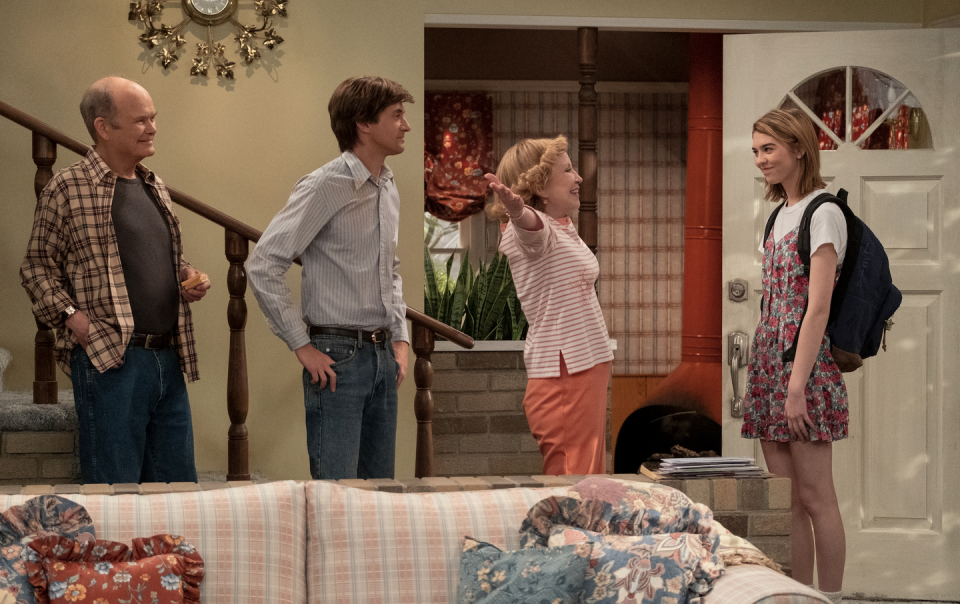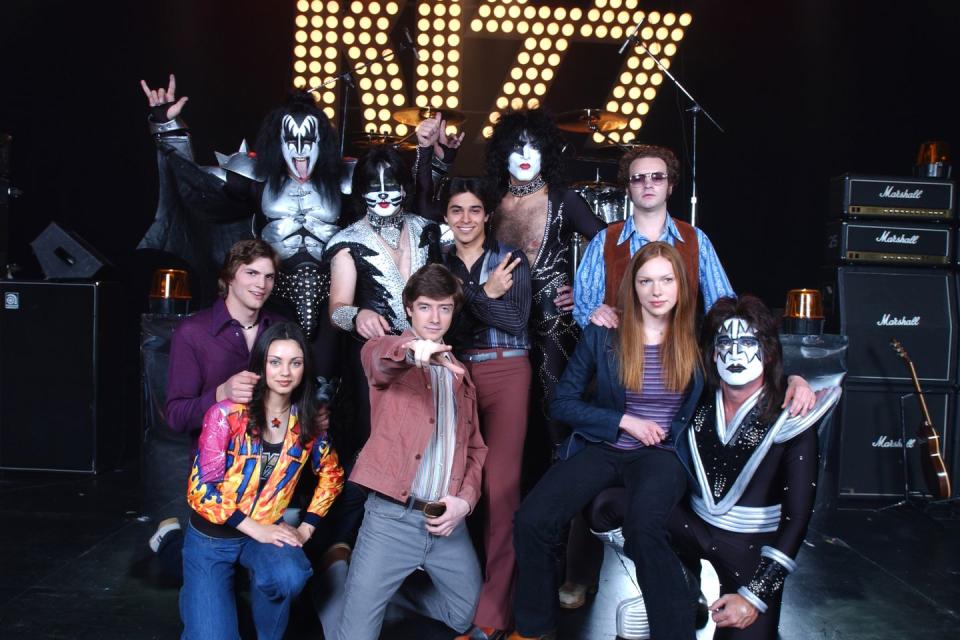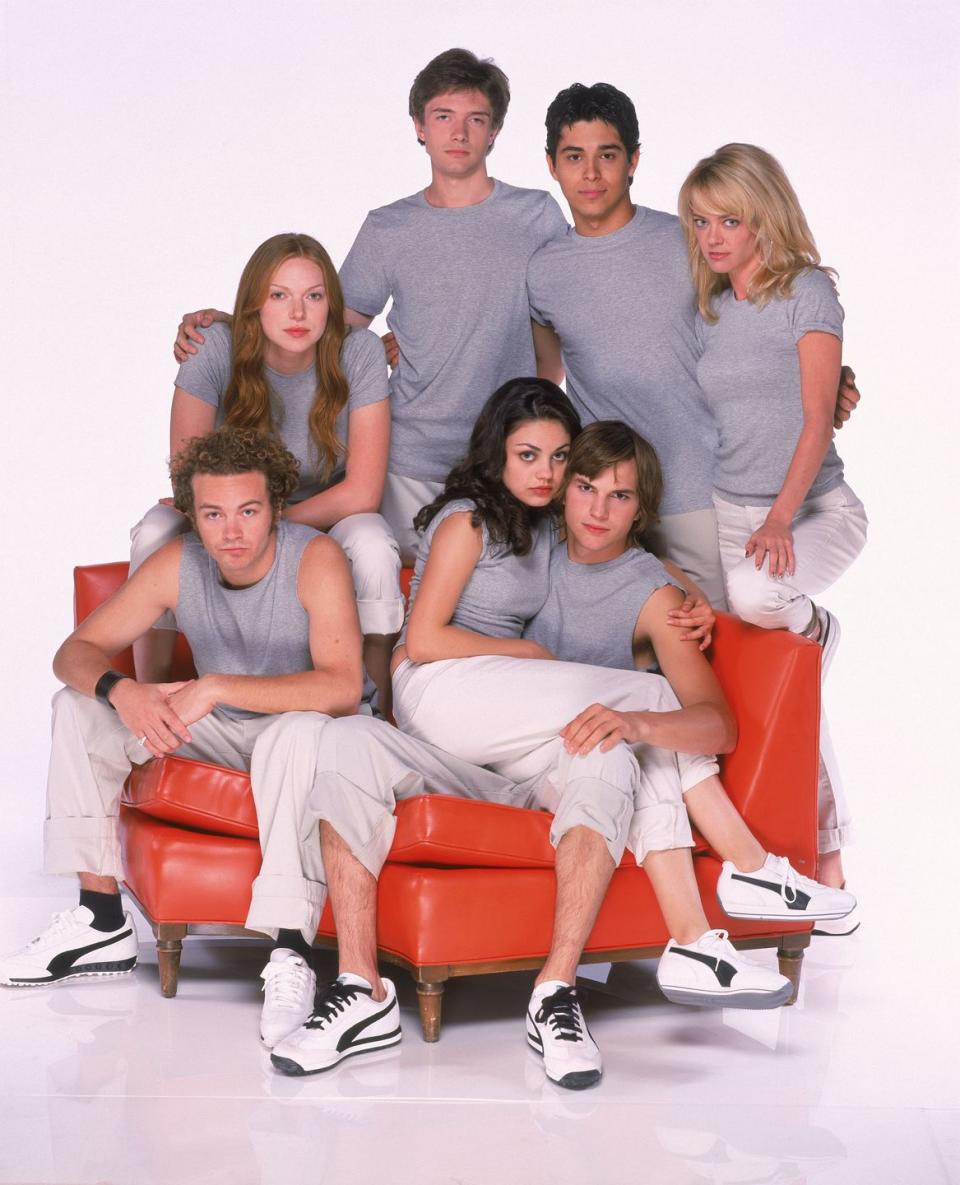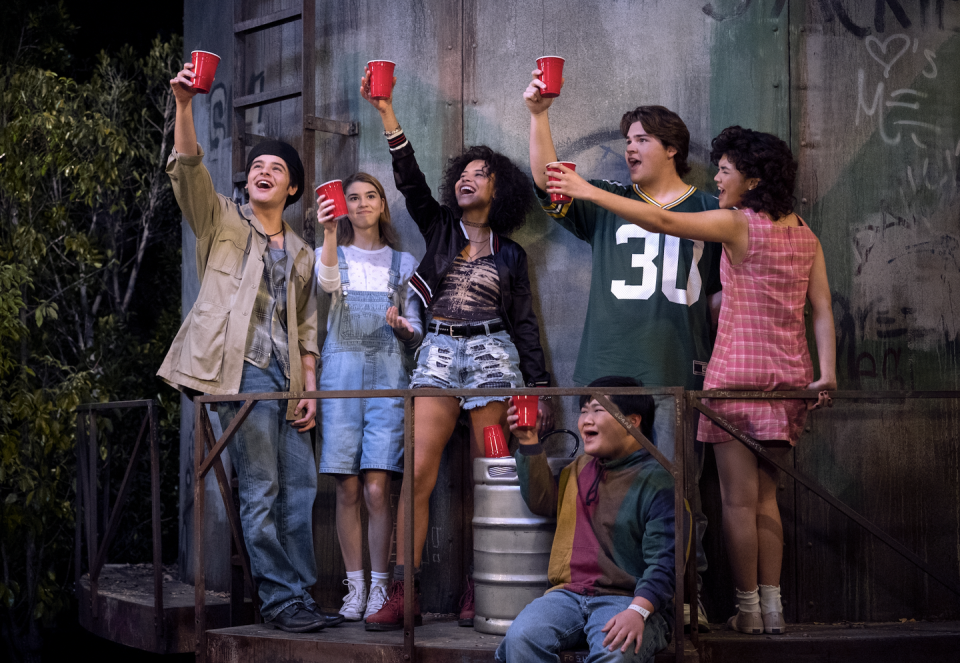All the other That '70s Show spin-offs you had no idea existed
That '90s Show has proved itself to be an unexpected hit with audiences and critics.
When news of the spin-off came to light, fans were conflicted. After all, the live-audience sitcom format hasn't exactly been a hit since the days of Friends, Frasier, and the like. Put simply, the single-camera and canned-laugher gimmick isn't how we're used to consuming comedy nowadays.
But when the new Netflix series hit our screens, viewers were pleasantly surprised by the charming and cheeky comedy, the fan-service throwbacks and guest appearances, and loveable characters both old and new.
The '90s Show is an unprecedented success, but it hasn't always been this way.
In fact, between the premiere of the hit original series That '70s Show and it's recent revival, there were other attempts at finding a successful spin-off. If you're unaware, there's good reason. Neither of these ventures made it past one season before a quick cancellation and erasure from pop culture.
Essentially, they were all misses, no hits.
But...we never forget. So, in the wake of this new comedy smash that everybody's talking about, let's take a look at the history of That 70's Show, and the failed spin-offs that came after it.

That '70s Show (1998)
Before we dissect the bad and the ugly, let's take a look at the good.
That '70s Show premiered on Fox in 1998, the brain child of creators Mark Brazill, and Bonnie and Terry Turner, quickly becoming a fan favourite. The over-the-top comedy and memorable characters made this show a network staple and would solidify itself as one of the foremost sitcoms in the late '90s through to the mid noughties.
In the series, we followed the everyday hijinks of a group of teenagers in Point Place, Wisconsin, headed by Eric Forman, who was accompanied by his gang of friends.
The show was notable for its physical humour and innovative visual gags. It paid no mind to the limitations of standard sitcom rules, instead playing with visual effects, set design, and narrative devices to keep its energetic and playful tone.
One of the most memorable recurring comedy scenes in the shows run came from the camera spinning rapidly between the fictional teens as they monologue directly into the lens in the middle of their basement hangout slash hotbox.
Another hilarious set piece usually appeared when the teens were at the mercy of Eric's parents while they were under the influence, sitting and accepting a verbal tirade from the Formans whilst the walls and set move around them, warping and shifting as they try and keep a straight face and play it cool.
The show can also be credited with bringing about some major future star power with the likes of Topher Grace, Laura Prepon, Mila Kunis, and Ashton Kutcher. These actors brought to life the at times absurd situational humour through their characters, which proved to be completely unique and memorable in their own right.

And though the show was titled after the decade in which it's set, the time period-specific jokes were not the central schtick. The show delicately balanced relevance and nostalgia as a backdrop rather than the main showcase.
That '70s Show worked. Really worked. So much so, that it would continue to run for years until its eventual conclusion in 2006. But it only took one year for creators to try their hand at the first spin-off attempt.
Hold on to your hats for this one, because we're going across the pond.
Days Like These (1999)
In 1999, not long after the original show's premiere, That '70s Show would be adapted for UK television in the form of an ill-fated spin-off known as Days Like These.
Nowadays, Days Like These exists in the form of bad quality clips on YouTube, since the series was so short-lived and wiped from the airwaves.
The problem with Days Like These? Well, adaptation is a strong word. In fact, this Brit-flipped series would actually serve as a complete word-for-word copy of the original show. The only real change that occurred between the two shows was the minor change of some character names, plus the swapping out of American-specific pop culture references to their UK counterpart.
This carbon copy style might be understood a little more with the knowledge that it was the same production company responsible for making the UK version, rather than a British production company taking the rights and moulding the idea into something more original or workable with a British sensibility.
After all, it's no secret that humour means something entirely different to British and American audiences, especially when it comes to television. Brits, by nature, favour a more cynical and jaded approach to comedy, which often results in sometimes teeth-grindingly cringey moments that we love to watch. On the other hand, American humour tends to lean towards a more positive light, playing with a more vaudevillian style of physical humour and outrageous situations.
That's not to say that British comedy has not been the more successful legacy at times. (Come on, it's fair to say that when it comes to the UK vs US variations of The Inbetweeners and Skins, us Brits can take the gold on those.) And there have certainly been shows in existence that can boast a victorious adaptation on both ends, most notably in the forms of Shameless and The Office. But probably best to assume these are the exceptions, not the rule.
Back to Days Like These. Although the series copied the otherwise well-received characters and episode arcs from its American twin, the difference in delivery and effectiveness was obvious. The extravagant and exaggerated comedy in That '70s Show, when filtered through a more stereotypically British performance and depiction, turned into something stunted and gauche.
What's more, the characters didn't seem to translate in the slightest. When it comes to their American equals, the definitions are made very clear;
Eric: The nerdy and sometimes highly-strung teen, Donna: His outspoken and feisty love interest, Jackie: The spoilt and demanding princess, Kelso: The dumb but loveable best friend, Fez: The naïve and fish-out-of-water foreign exchange student, and Hyde: The rebellious and sarcastic stoner.

These characters were so well-rounded and clear, that you could identify each one with your eyes closed.
In Days Like These, the characters didn't seem to have such notable distinctions, meaning that they all melded into one singular character without the same level of charm and charisma as their originators. (Mind you, this was hardly the fault of the actors, who were likely doing the best they could with the copy-and-paste material that was doomed to fail.)
In the end, Days Like These simply didn't hit in the same way That '70s Show did, which led to the series being cancelled shortly after airing. Of the thirteen episodes shot, only ten eventually made it to air.
Maybe this was a lesson. Perhaps That '70s Show was a lightning-in-a-bottle type phenomenon.
But that didn't mean the creators wouldn't take another swing at a spin-off a few years later.
That '80s Show (2002)
Fast forward to 2002, when we were about to get the answer to the question:
"So, That '70s Show was pretty good...What decade can we do next?"
Naturally, the '80s seemed like the suitable choice. Big hair, even bigger shoulder pads...this decade seemed ripe for satire. But though the iconography of a time period might be hilarious in hindsight, we would soon be shown that nostalgia alone isn't enough to rustle up some laughs.
Taking place in San Diego, That '80s Show followed a group of twenty-somethings as they navigated through life in the...well, '80s. By way of star power, you'd probably recognise a young Glenn Howerton or Chyler Leigh from their later turns in It's Always Sunny In Philadelphia, or Not Another Teen Movie. But there's not much else from this series that has permeated television history.
That '80s Show made one crucial mistake when it came to the time-upgrade. Whereas That '70s Show used the decade references as a jumping-off point, its spin-off would rely heavily on '80's-based jokes and gags. In the original show, there are allusions to Star Trek, perms, and other significant pop culture contributions of the time, but these were usually in the form of quick witticisms or loving mockery.
But in That '80s Show, period references were the joke. The assumption that the past was inherently and unquestionably funny led to buzzwords being thrown around endlessly. Miami Vice! Giant phones! Ronald Reagan! (Cue unhinged sound of canned laughter).
This humour drawn from stereotype was used in the characters themselves, too. In That '70s Show, the characters were distinctive and individual, and the well-blended ensemble and ever-changing adventures and arcs meant that Eric and the gang often moved between the blurred lines of being recognisable in their archetypes whilst not being hindered by them.
The characters in That '80s Show on the other hand were stereotypical, yet they didn't stand out. Other than very obvious character tropes (a punk, a pop princess), there wasn't anything particularly memorable about these figures compared to their Point Place originals.
On top of neglecting to include much of the visual creativity, this spin-off missed the mark when it came to trying to recreate what was so successful about the original series. It wasn't the era that was the most beloved element— it was everything else around it.
That '70s Show (2006)
Unfortunately, despite its earlier triumph with viewers, That '70s Show would eventually, as it's known in the world of television, jump the shark.
After the show's star Topher Grace left before the finals series to pursue a career in movies, the show would start to decline in quality and audience response. Alongside him, Ashton Kutcher also stepped back, and would only appear in a few episodes in the final season.
In the show's run-up to the finale, there were some questionable choices made, resulting in nonsensical character arcs and decisions. (For example, the fan-favourite relationship between Jackie and Hyde dissolved when it was revealed that Jackie had secretly got back together with Kelso.)
Plus, the introduction of a new character Randy (played by Josh Meyers) was met with negative response from audiences. Intended to be Eric's replacement, Randy was not met with the same love from fans on account his lack of chemistry with the other characters, as well as not enough time being left to build a sufficient backstory or relationship with the viewers.
On top of this, the show's actors were clearly in the process of moving on, changing their appearances for their other new acting roles. Donna's signature red locks were suddenly dyed blonde, and Kelso's fluffy layers were cut short to adhere to his new Hollywood image. By the time the series came to an end in 2006, the cast were looking less like teens in the '70s, and more like adults cosplaying as such.
When the show ended, it seemed like that would be the end of the storied journey of That '70s Show.
Until now, of course.
That '90s Show (2023)
After all other attempts, it seems like the creators of That '70s Show have finally made the perfect spin-off.

Fans have quickly fallen for the fresh and funny take on the decade-based sitcom, finding themselves hooked on the family dynamic between Leia, Red, and Kitty, the potential romance between Leia and Jay, and the dynamic characters (particularly with the loveable Ozzie).
So, why does That '90s Show work when the other spin-offs didn't? Well, it's impossible to pin-point exactly what this particular revival is doing so right. Much like it's predecessor, and as if often the way with good television, it might just be down to the lucky combination of cast chemistry, successful comedy, and of course, being in the right place at the right time.
Perhaps the time gap between the original show and this one is long enough for audiences to appreciate That '90s Show in it's own regard, whilst still enjoying the call-backs that honour the previous series. It might even be that the 'sitcom' as a format is making its way back into the cultural zeitgeist, though it'll probably take more than one hit to make audiences settle into such a genre again in the same way they did back in the '90s.
Either way, the history behind how That '90s Show came to be is a long one, with lots of stops and plenty of flops. But in the end, it looks like trial and error has resulted in what could potentially be a new fan-favourite comedy that we hope will continue to hit our screens for a while yet. (That '00s Show, anyone?)
You Might Also Like


